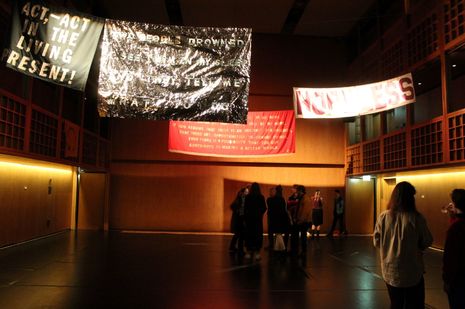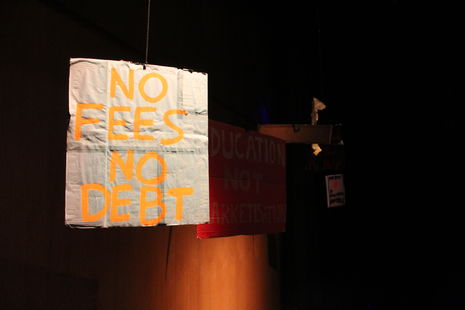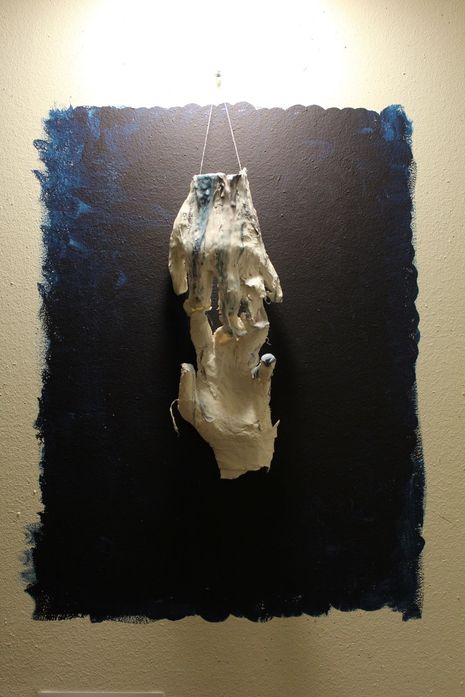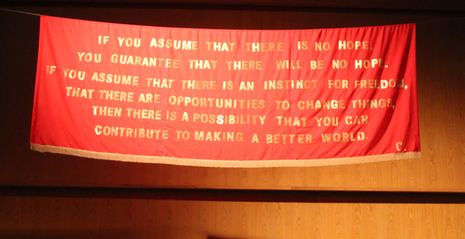Imagining more futures at the Queens’ Arts Festival
Damian Walsh looks back at this year’s powerful and poignant activism-focused Queens’ Arts Festival exhibition

Stepping in from the noise of the picket lines to this year’s Queens’ Arts Festival feels like a natural transition. Placards and banners festoon each scene; posters holding the university to account are pasted on the walls at both. In this current climate of demonstration and disruption, Queens’ Arts Festival seems to fit seamlessly into the Cambridge landscape. Just as Extinction Rebellion has blockaded the edge of Trumpington Road, MORE FUTURE has occupied Queens’, and this year’s festival feels more timely than ever.

And a close focus on timeliness is central to the festival itself. Behind its mobilizing theme, MORE FUTURE, there’s a sensitive recognition that brighter futures can only be built on the foundations laid by the activism of the past. The exhibition gets into gear straight away with an emblazoned banner warning the unsuspecting viewer that "No system of society is immutable, no establishment impregnable". (This is not your ordinary detached and bourgeois art show; Cambridge, think on your sins.) These words are lifted from the pages of The Shilling Paper, a radical Cambridge newspaper which ran from 1968 to 1975 and whose anti-establishment message had a hand in the creation of CUSU. MORE FUTURE loosely assembles itself around three quotes from the Shilling, each one lending a slightly different atmosphere and focus to each section of the exhibition. The first greets you as you enter; the second, "The impact of a person on a structure can be great indeed", has to almost be ducked under to get to the next section, and the final quotation ("The struggle is for real-life") is strung defiantly across the top of a stairwell. The relevance of the pieces to each section’s theme doesn’t always seem obvious, but orienting the exhibition around such a focused structure is an ambitious feat nonetheless. And where would activism be without ambition?

An atmosphere of solidarity with the activists of the past runs through the exhibition, which splices up the politically-focused art of current students with archive material of past Cambridge protests. Photos from the 2010 occupation of Old Schools (now receiving a present-day re-enactment at "Solidarity College") sit side-by-side with art demanding climate action; Jenny Holzer’s Light the Fight protest on World AIDS Day 2018 coexists beside Ryan Montgomery’s ingenious Context cut-up poem, showing how far we (or our PM, at least) still need to come in rooting out homophobia. All this emphasis on archives runs the risk of coming off more like a local history display than an art exhibition, yet MORE FUTURE pulls it off, creating a sense instead of past activism informing the present.

At times, bringing old works of activism into this contemporary space adds new resonances to the pieces. Ribbons, assembled collectively by the QAF committee, is an uncomfortable example of this. Originally devised as a protest during the May 2019 Senate House debates over changes to the disciplinary procedures, which would especially impact the handling of sexual assault cases, in the wake of the recent sexual misconduct allegations surrounding Tit Hall this piece only feels more urgent with time.
There are some hauntingly beautiful pieces in this exhibition as well. Sarah Strachan’s Contingent on carbon stood out in particular for its eerie elegance, superimposing real ferns onto skin-like latex which billows out slowly from the breeze of desk fans, resembling wind turbines in miniature. It’s an arresting piece, perfectly poised between activism and aesthetic. Strachan creates a powerful sense of abjection which reminds us that imagining alternative futures – where "humans and plants co-exist" – means stepping out of our comfort zones. Continuing the environmental theme, Noor A. Noor’s interactive sound installation also deserves a mention for innovatively interrogating the divide between nature and culture.

It’s often difficult, however, to navigate the overlap between political message and artistic intentions – something Oluwasemilore Delano acknowledges in the notes to her Saturday Brunch, a piece already well-known to Varsity readers, and which makes a wonderful addition to the show. Delano laments that the "mundane moments" she so compellingly captures – sharing brunch with family, braiding friends’ hair – inevitably become "bound up in interpretations and assumptions", layers of "cultural and racial questioning" that are out of her control. It feels perverse that these moments of fleeting intimacy face this kind of intrusion. Can a family not even eat a meal without risking being profiled? Not all the pieces here carry off this tension as gracefully as Delano achieves, however. As to be expected in such a politically-oriented exhibition, some works do come across as feeling more like a circle-jerk (literally in the case of Queens’ Queer Collective’s semen-stained portrait of Jacob Rees Mogg) than either engaged activism or thoughtfully-composed art.

The feeling’s fleeting, however; like any successful protest movement, MORE FUTURE feels greater than the sum of its parts. As you step into the Fitzpatrick Hall, rechristened for the week as the "Banner Hall", the Festival’s vision emerges fully. Above Pia Rose Scattergood’s atmospheric, disorienting sound installation, multi-coloured and iridescent banners have been strung out across the hall, the low lighting catching their lettering. This isn’t the same old Fitzpatrick Hall you might have visited for a lecture or rehearsal – it’s the university reimagined. The empty Hall begins to feel like a rallying space, a space for organising, socialising, shouting, laughing, or even (as the banners dare to hope) for "making a better world". While I’m here, two attendees place their wine glasses down and start to dance together across the floor, their shadows mixing with those of the banners overhead. I wonder if this wasn’t exactly what the committee intended for the space. "The impact of a person on a structure can be great indeed"; or, translated, perhaps, from its high technicality: the work, be it art or life, depends on the people.
 News / Clare Hall spent over £500k opposing busway 24 December 2025
News / Clare Hall spent over £500k opposing busway 24 December 2025 Comment / The ‘class’ of Cambridge24 December 2025
Comment / The ‘class’ of Cambridge24 December 2025 News / Caius mourns its tree-mendous loss23 December 2025
News / Caius mourns its tree-mendous loss23 December 2025 Comment / Yes, I’m brown – but I have more important things to say22 December 2025
Comment / Yes, I’m brown – but I have more important things to say22 December 2025 News / Girton JCR publishes open letter expressing solidarity with Palestine25 December 2025
News / Girton JCR publishes open letter expressing solidarity with Palestine25 December 2025










